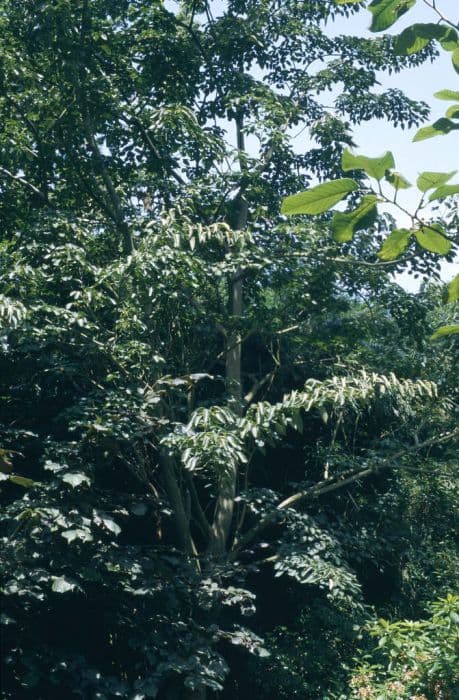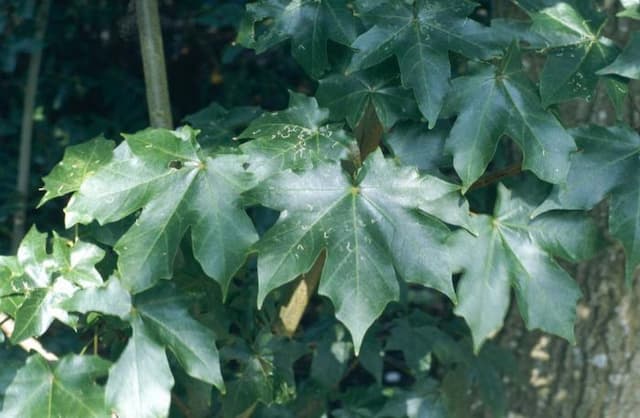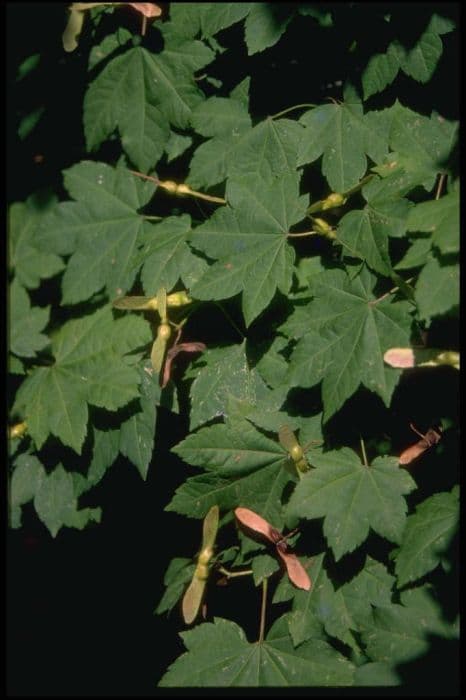Japanese Maple Acer palmatum 'Deshojo' (P)

ABOUT
The Japanese maple known as 'Deshojo' is admired for its distinctive foliage and aesthetic appeal throughout the changing seasons. The plant is characterized by its vivid leaves, which can turn various shades ranging from a fiery red to a delicate pink, especially in the spring. As the plant matures through the seasons, the leaves may transition to a green color with hints of red, creating a visually striking contrast against the branching patterns. The leaves themselves have a unique shape, with each exhibiting multiple lobes that are deeply dissected, creating a fine, feathery appearance. This intricate leaf structure catches light and moves delicately with the breeze, adding to the plant's ornamental value. The 'Deshojo' can also produce small, inconspicuous flowers that are followed by samaras, which are winged fruiting bodies typical of the Japanese maple family and add another layer of interest to the plant's display. The branches and bark have a smooth texture and can provide a strong visual element, especially in the winter months when the plant may lose its leaves, revealing the underlying structure of the limbs against the backdrop of the colder season. The 'Deshojo' Japanese maple presents an attractive appearance for gardeners and landscape enthusiasts who appreciate plants with a changing palette and delicate structures that create a serene and picturesque setting.
About this plant
 Names
NamesFamily
Sapindaceae
Synonyms
Japanese Maple, Smooth Japanese Maple, Palmate Maple
Common names
Acer palmatum 'Deshojo'.
 Toxicity
ToxicityTo humans
The Japanese maple is generally considered to be non-toxic to humans. Ingestion of leaves or other parts of the plant typically does not cause serious harm.
To pets
The Japanese maple is also considered non-toxic to pets. It should not cause significant illness if pets accidentally ingest parts of the plant. However, it's always best to prevent pets from eating plants as individual reactions can vary.
 Characteristics
CharacteristicsLife cycle
Perennials
Foliage type
Deciduous
Color of leaves
Varies
Height
6-8 feet (1.8-2.4 meters)
Spread
6-8 feet (1.8-2.4 meters)
Plant type
Tree
Hardiness zones
5-9
Native area
Japan
Benefits
 General Benefits
General Benefits- Ornamental Appeal: P adds aesthetic value to gardens with its distinctive red leaves, especially vibrant in spring and autumn.
- Shade Provision: As it matures, P can offer shade in garden settings, creating cool, sheltered areas.
- Habitat for Wildlife: Birds and other small wildlife may nest in P or use it as shelter.
- Seasonal Interest: P provides year-round interest with changing leaf colors and textures throughout the seasons.
- Compact Size: Suitable for smaller gardens or growing in containers due to its relatively small size compared to other maples.
- Low Maintenance: Once established, P requires minimal care beyond occasional pruning and watering during dry spells.
- Soil Adaptability: P can adapt to a range of soil types, although it prefers well-drained, slightly acidic soil.
 Medical Properties
Medical PropertiesThis plant is not used for medical purposes.
 Air-purifying Qualities
Air-purifying QualitiesThis plant is not specifically known for air purifying qualities.
 Other Uses
Other Uses- Photography Prop: The Japanese Maple is often used by photographers as a natural prop due to its vibrant foliage, adding depth and beauty to portrait and landscape photography.
- Bonsai Inspiration: While often grown as a standard tree, the Deshojo variety of Japanese Maple is popular among bonsai enthusiasts for creating miniature landscapes due to its small leaf size and vibrant color.
- Culinary Decoration: The bright leaves of the Deshojo can be used as natural garnishes to add a splash of color to gourmet dishes, although they are not edible.
- Artistic Muse: The striking appearance of Deshojo Japanese Maple inspires artists and craftsmen, serving as a subject for paintings, sculptures, and other forms of art.
- Feng Shui Element: In the practice of Feng Shui, the Deshojo may be used to bring positive energy to a garden space, as its red leaves are associated with fire, one of the five elements.
- Seasonal Celebrations: In Japan, the changing leaves of the Japanese Maple are celebrated during autumn festivals and are a symbol of the changing seasons.
- Craft Material: Fallen leaves from the Deshojo can be used in crafts such as leaf pressing or to create natural dyes for fabrics or paper.
- Urban Landscaping: Due to its compact size and aesthetic appeal, the Japanese Maple is used in urban planning to beautify city parks and streetscapes.
- Film and Theatre Settings: The Deshojo's striking red foliage makes it a suitable plant for setting the scene in film and theatre productions, especially to denote a particular season or to add visual interest.
- Educational Tool: Horticulturalists and educators may use the Japanese Maple as a teaching specimen to discuss topics such as plant biology, taxonomy, and the diversity of plant forms.
Interesting Facts
 Feng Shui
Feng ShuiThe Japanese Maple is not used in Feng Shui practice.
 Zodiac Sign Compitability
Zodiac Sign CompitabilityThe Japanese Maple is not used in astrology practice.
 Plant Symbolism
Plant Symbolism- Beauty: The variety 'Deshojo' of the Japanese Maple species is particularly known for its striking red-colored leaves, which are often seen as embodying beauty and aesthetic appeal.
- Change: As a deciduous tree, the Japanese Maple 'Deshojo' represents change, through its seasonal leaf transformations signaling the passing of time and the cyclic nature of life.
- Peace: The Japanese Maple is a common element in Asian gardens, particularly Japanese Zen gardens, where it symbolizes peace through its calming presence and soothing shape.
- Balance: The form of the 'Deshojo' with its finely cut leaves and a well-proportioned canopy often reflects balance and harmony, which is a core principle in many Eastern philosophies.
- Grace: With its delicate leaves and branches that sway gently with the breeze, the Japanese Maple 'Deshojo' symbolizes elegance and gracefulness.
 Water
WaterThe Japanese Maple, commonly known as Deshojo, requires consistent moisture, especially during the hot summer months, but does not do well with oversaturated soil. It's best to water this plant deeply once a week, providing about 1.5 gallons for a medium-sized tree to ensure the soil is moist but not soggy. In periods of drought or extreme heat, you may need to water it twice a week. Decrease watering to once every two weeks during the cooler seasons when the plant does not require as much moisture. Always check the top few inches of soil for dryness before watering to avoid overwatering which can lead to root rot.
 Light
LightThe Japanese Maple prefers partial shade or filtered sunlight, avoiding the harsh afternoon sun that can scorch its delicate leaves. An ideal spot would be where the plant can receive morning sun and afternoon shade, or a location with dappled sunlight throughout the day. Ensure the Deshojo is protected from strong winds, which can also damage the leaves.
 Temperature
TemperatureJapanese Maples thrive in a temperature range between 60 to 80 degrees Fahrenheit. The Deshojo variety can tolerate minimum temperatures down to 20 degrees Fahrenheit but should be protected from frost and extreme cold. Ideal growing conditions include temperate climates with distinct seasons without extreme temperature fluctuations.
 Pruning
PruningThe Deshojo Japanese Maple requires pruning to maintain its shape, improve air circulation, and remove dead or diseased branches, thereby encouraging healthy growth. Pruning should be done in the late winter or early spring before new growth starts. Thinning out the canopy to let light into the inner branches can be done every 2 to 3 years, but major pruning should be infrequent to maintain the tree's natural form.
 Cleaning
CleaningAs needed
 Soil
SoilThe Japanese Maple 'Deshojo' thrives in a well-draining soil mix consisting of one part peat, one part pine bark, and one part coarse sand or perlite. The ideal soil pH for this plant is slightly acidic, ranging from 5.5 to 6.5.
 Repotting
RepottingJapanese Maples such as 'Deshojo' should generally be repotted every two to three years to prevent root crowding and to replenish nutrient-rich soil.
 Humidity & Misting
Humidity & MistingJapanese Maple 'Deshojo' tolerates a wide range of humidity levels but thrives best with moderate humidity around 40-60%.
 Suitable locations
Suitable locationsIndoor
Ensure bright, indirect light and consistent moisture for indoor 'Deshojo'.
Outdoor
Place 'Deshojo' in filtered sunlight and shelter from harsh winds.
Hardiness zone
5-8 USDA
 Life cycle
Life cycleThe life of the Japanese Maple 'Deshojo' begins with seed germination, which requires stratification to break dormancy. Following germination, the seedling stage involves the growth of the first leaves and root system development. As it enters the juvenile phase, the plant grows rapidly, producing more leaves and increasing in height and branch complexity. The mature phase is marked by the plant reaching its full size, exhibiting its characteristic bright crimson-red leaves in spring and developing reproductive structures like flowers and samaras (winged seeds). Upon successful pollination, these seeds will disperse, sometimes with the help of wind due to their winged nature, potentially establishing new plants nearby. Finally, as the plant ages and enters senescence, growth slows down, and it may become more susceptible to environmental stress, diseases, and pests before eventually dying.
 Propogation
PropogationPropogation time
Late summer
The Japanese Maple 'Deshojo' is most commonly propagated through grafting, which is typically done in late winter or early spring before the tree breaks dormancy. In grafting, a small branch or bud—known as the scion—is taken from a desirable parent tree and joined onto the rootstock of another maple that provides a vigorous root system. The scion should be a piece of the current year's growth, about 2 to 6 inches long (5 to 15 centimeters). The grafting area is wrapped with grafting tape or a similar material to hold the pieces securely together and prevent drying. Over time, ideally during the growing season, the tissues of the scion and rootstock grow together, forming a union from which the scion develops into a new tree, genetically identical to the parent 'Deshojo'.









